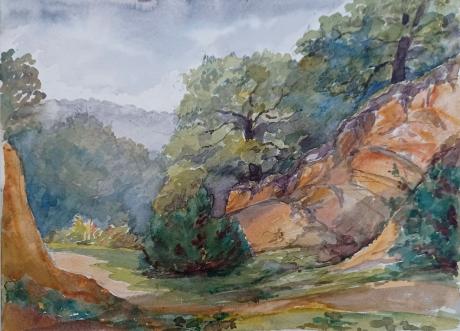inscribed and dated " Sand Quary Near Dorking Sunday Rain, Aug 29 1858" and signed with initials "LWT"
Tom and Laura Taylor anmd thence by descent
Betchworth Quarry is a stunning chalk downland site set within the Surrey Hills Area of Outstanding Natural Beauty and part of the North Downs.
Rich in flowers such as horseshoe vetch (the food plant for for the chalkhill blue butterfly) and several types of orchids, this chalk grassland reserve is best visited during the summer months. A yew and broad-leaved woodland can also be found around the edge of this former chalk quarry.
Betchworth Quarry and Lime Kilns is a 27-hectare (67-acre) nature reserve north of Betchworth in Surrey. Betchworth Quarry only is managed by Surrey Wildlife Trust. It is part of the Mole Gap to Reigate Escarpment Site of Special Scientific Interest and Special Area of Conservation.
This chalk downlands site is part of the North Downs and the Surrey Hills Area of Outstanding Natural Beauty. It has a rich variety of flowering plants, including orchids. The lime kilns house a variety of bat species, such as the whiskered, Natterer's, brown long-eared, Brandt's and Daubenton's.
Chalk has been quarried on a small scale in the area around Dorking since at least the 1600s. In 1865 the Dorking Greystone Lime Company was incorporated to open a large quarry at Betchworth. A standard gauge siding was laid from Betchworth railway station to the lime kilns built at the foot of the North Downs escarpment.
Laura Wilson Barker (6 March 1819 – 22 May 1905), was a composer, performer and artist, sometimes also referred to as Laura Barker, Laura W Taylor or "Mrs Tom Taylor".
She was born in Thirkleby, North Yorkshire, third daughter of a clergyman, the Rev. Thomas Barker. She studied privately with Cipriani Potter and became an accomplished pianist and violinist. As a young girl Barker performed with both Louis Spohr and Paganini. She began composing in the mid-1830s - her Seven Romances for voice and guitar were published in 1837. From around 1843 until 1855 she taught music at York School for the Blind. During this period some of her compositions - including a symphony in manuscript, on 19 April 1845 - were performed at York Choral Society concerts.
On 19 June 1855 she married the English dramatist, critic, biographer, public servant, and editor of Punch magazine Tom Taylor. Barker contributed music to at least one of her husband's plays, an overture and entr'acte to Joan of Arc (1871), and provided harmonisations as an appendix to his translation of Ballads and Songs of Brittany (1865).
Her other works include the cantata Enone (1850), the violin sonata A Country Walk (1860), theatre music for As You Like It, (April 1880), Songs of Youth (1884), string quartets, madrigals and solo songs. Her choral setting of Keats's A Prophecy, composed in 1850, was performed for the first time 49 years later at the Hovingham Festival in 1899. The composer was present.
Several of Barker's paintings hang at Smallhythe Place in Kent, Ellen Terry's house.
Barker lived with her husband and family at 84 Lavender Sweep, Battersea. There were two children: the artist John Wycliffe Taylor (1859–1925), and Laura Lucy Arnold Taylor (1863–1940). The Sunday musical soirees at the house attracted many well-known attendees, including Lewis Carroll, Charles Dickens, Henry Irving, Charles Reade, Alfred Tennyson, Ellen Terry and William Makepeace Thackeray.
Tom Taylor died suddenly at his home in 1880 at the age of 62. After his death, his widow retired to Porch House, Coleshill in Buckinghamshire, where she died on 22 May 1905, aged 86.

